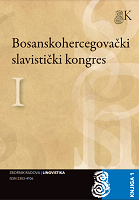Prodor bosanskih leksičkih značajka u dubrovački govor 17. i 18. stoljeća
The penetration of Bosnian lexical elements into the spoken language of Dubrovnik of the 17th and 18th centuries
Author(s): Ivana Lovrić JovićSubject(s): Historical Linguistics, Comparative Linguistics, Sociolinguistics, South Slavic Languages, 17th Century, 18th Century, Turkic languages, Stylistics
Published by: Slavistički komitet BiH
Keywords: Dubrovnik-people speech; Turkish loanwords; stylized dramatic language; administrative language; Dubrovnik francesaria; Dubrovnik testaments;
Summary/Abstract: The work analyses the Bosnian lexemes in two bodies of texts: the 17th and 18th centuries Dubrovnik wills written in the Croatian language and the so-called francesaria – adaptations of comedies by Molière to Dubrovnik speech. As the studied period did not bring forth any major names in literature and, as a result, no comprehensive linguistic monographs, the mentioned linguistic material may be considered fairly representative of Dubrovnik speech in the 17th and 18th centuries. This is supported by the fact that these texts belong to different language genres: administrative language and stylized (dramatic) language. Although the Bosnian element left its mark on only certain portions of the mentioned two bodies, it should not be considered a sporadic or accidental phenomenon. Namely, in the testamental material the wills by Bosnian immigrants abound in Turkisms, whereas in the francesaria the Bosnian lexical element mostly occurs in the stylogenic function as a dramatic part of one of the standard characters – the Bosnian. This may lead to a wrong conclusion that the Bosnian element in Dubrovnik speech of the 17th and 18th centuries does not actually exist (except as part of the general Croatian lexica). Yet the fact that the translators, the autochthonous inhabitants of Dubrovnik, knew how to stylize the Bosnian’s speech with Turkisms tells best that they got to know them directly – probably through the living speech of the Herzegovian hinterland or through multiple trade links with Bosnia.
Journal: Bosanskohercegovački slavistički kongres
- Issue Year: I/2012
- Issue No: 1
- Page Range: 427-434
- Page Count: 8
- Language: Croatian

